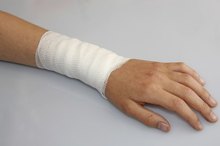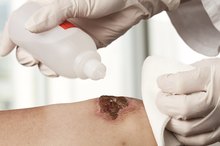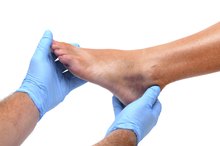What does fact checked mean?
At Healthfully, we strive to deliver objective content that is accurate and up-to-date. Our team periodically reviews articles in order to ensure content quality. The sources cited below consist of evidence from peer-reviewed journals, prominent medical organizations, academic associations, and government data.
The information contained on this site is for informational purposes only, and should not be used as a substitute for the advice of a professional health care provider. Please check with the appropriate physician regarding health questions and concerns. Although we strive to deliver accurate and up-to-date information, no guarantee to that effect is made.
Why High Levels of Potassium in Burn Patients?
Burns require specific emergency care and continuous treatment. Preference is given to fluid hydration, swelling and its complications, establishing and maintaining an airway, nutritional supplements, a catheter for monitoring urine output, X-rays and possible skin grafts. Burns damage the skin, which protects the body from fluid loss and infection, and can result in renal failure, life-threatening infections, shock and death. Fluid loss alters the balance of potassium, sodium, chloride, calcium and water, requiring constant replacement and monitoring.
Types of Burns
Burns result from exposure to heat from fire or liquids, electricity, chemicals and radiation. Categories of burns are first-degree, second-degree and third-degree. First-degree burns damage the epidermis or outer layer of tissue and result in redness and pain. Second-degree burns damage epidermal and dermal tissue, the second layer of skin, and result in redness, pain and blisters. Third-degree burns damage skin down to the nerves, muscles, tendons and possibly bones, leaving a charred appearance with no pain as a result of nerve damage.
- Burns result from exposure to heat from fire or liquids, electricity, chemicals and radiation.
- Second-degree burns damage epidermal and dermal tissue, the second layer of skin, and result in redness, pain and blisters.
Significance
How to Heal a Light Skin Burn
Learn More
With minor burns, treatment can occur at home, in the doctor's office and the emergency room based on the size of the burned areas of the body affected. The care for second-degree and third-degree burns requires emergency room care and frequently placement in a burn treatment center. When deep tissues are damaged, rapid fluid loss, including electrolytes, minerals and water, leads to severe dehydration, which requires continuous replacement with intravenous solutions.
Fluid Replenishment
Lactated Ringers is the intravenous fluid of choice for hydration with severe burns in adults and includes sodium chloride, sodium lactate, potassium chloride, calcium chloride dihydrate and water 3. Fluid hydration requires heart monitoring because of potassium increases which occur as a result of cellular and tissue damage, releasing potassium into the bloodstream. Sodium, chloride, calcium and potassium levels require replacement within the initial phases of treatment for burns to prevent shock from extreme fluid loss.
- Lactated Ringers is the intravenous fluid of choice for hydration with severe burns in adults and includes sodium chloride, sodium lactate, potassium chloride, calcium chloride dihydrate and water 3.
- Fluid hydration requires heart monitoring because of potassium increases which occur as a result of cellular and tissue damage, releasing potassium into the bloodstream.
Nutrition
How Long Does It Take to Heal a Second Degree Burn?
Learn More
Burns require increased calorie replacement to balance the damage to tissues and to aid in wound healing. If the burns affect the ability to eat, a tube may be placed into the stomach for liquid nutrition. The diet for burn patients, regardless of the method of administration, is high in calories and high-protein with vitamin and mineral supplements. Oral diets include fruits and vegetables, lean meats, fish, beans and tofu for protein.
- Burns require increased calorie replacement to balance the damage to tissues and to aid in wound healing.
- The diet for burn patients, regardless of the method of administration, is high in calories and high-protein with vitamin and mineral supplements.
Related Articles
References
- Tampa General Hospital: Regional Burn Center
- Burn Surgery: Managing The ABC's In The Burn Patient
- Drugs.com: Lactated Ringers
- MedlinePlus: Hyperkalemia
- Hilton G. Thermal Burns: The ABCs are crucial, since the major threat is often inhalation injury. Am J Nurs. 2001;101(11):32-34. doi:10.1097/00000446-200111000-00017
- Cleveland Clinic. Burns. Updated August 31, 2017.
- Thom D. Appraising current methods for preclinical calculation of burn size - A pre-hospital perspective. Burns. 2017;43(1):127-136. doi: 10.1016/j.burns.2016.07.003.
- Knowlin, L., Stanford, L., Moore, D., Cairns, B., & Charles, A. (2016). The Measured Effect Magnitude of Co-Morbidities on Burn injury Mortality. Burns : Journal of the International Society for Burn Injuries, 42(7), 1433–1438. http://doi.org/10.1016/j.burns.2016.03.007
Writer Bio
Helen Messina started writing in 2010. She is a registered nurse with experience in rehabilitation, long-term/subacute care, pediatric/adult home care and has worked in acute care facilities in Florida, Pennsylvania, New Jersey and New York. Messina's specialties include neurology, cardiac and renal care. She holds an associate degree in nursing from Gannon University.









